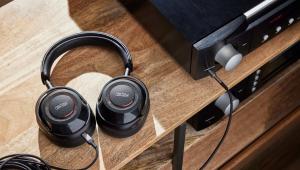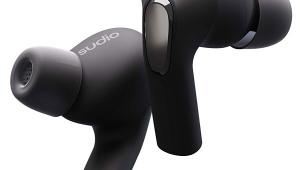Review: UrbanEars Zinken Headphone

In our roundup of $59 headphones, Urban Ears' Plattan won our testers over with its combination of solid performance, comfort, and minimalist style. The company's now introduced the Plattan's grown-up successor, the Urban Ears Zinken ($140), a more feature-packed model that shares styling cues with the older 'phone but is aimed squarely at DJs and the far larger market of folks who want to look like they spend their nights behind the wheels of steel.
Available in a dizzying range of colors, the Zinken features swiveling earcups, folds down for compact storage. While this is based around a 40 mm driver, it isn't, as had been rumored, a full-sized can; rather, it's an on-the-ear model, a form factor that should appeal to DJs who favor classic portables such as the Sennheiser HD-25 series, or for fans of electronic dance music or hip hop who might otherwise be interested in bass-forward portables like the Beats Mixr, but are put off by flashy graphics. From a strictly visual perspective, these most resemble the various DJ-oriented models from the similarly design-focused AIAIA - clean, modern, and minimal in look (so minimal that there's no traveling case or bag included with these portable headphones). Frankly, I think the Zinken is a darned good-lookin' piece of audio equipment. Maybe you won't want to pack it away.
The Zinken has one truly awesome feature - the "TurnCable" it ships with terminates in a 1/4-inch plug at one end, a 1/8-inch plug on the other. Depending on the gear you want to interface with, you simply reverse the cable - the left earpiece has a 1/4-inch input jack, the right a 1/8-inch (you can also use the unused jack to share your music with somebody else; though this would likely have to be another Zinken wearer, via another TurnCable, unless you've got some adapters on hand). The design is sheer genius, and one that scores the Zinken and Urban Ears/Zouindustries a lot of points, regardless of the sound of the 'phones. I wish everyone in the headphone biz would adopt this approach, frankly. I could do without seeing another adapter again. (And, I should point out, removing the need for an adapter lessens the pain of the Zinken not shipping with a carrying case. Somewhat.)
Performance
But hey. . . we're all nerds here, so we'll put those aesthetic considerations aside and think about how the Zinken fits, feels, and - most importantly - sounds.
Given the on-ear configuration, I found the clamping pressure a bit high for long listening sessions. That said, the headband is easily adjustable, and the swiveling earcups give you some wiggle room if you want to make adjustments on the fly. Still, I found the Zinken a bit uncomfortable when wearing thick-rimmed glasses, so try before you buy.
Compared to a couple of our fave headphones that appeal to DJs and the DJ-oriented - the Beats Pro and the new V-Moda M-100 - the Zinken sounds quite dark, with a resonant emphasis in the upper bass that lends the midrange some rather unnatural honkiness - not a totally uncommon sonic signature these days. While this balance works fine for electronic music, I'm not sure I would recommend this headphone to someone whose listening diet consisted mainly of electric or acoustic instrumentation.
The Zinken does have some of the Pro's sub-bass punch - turned up a bit louder than might be healthy, the bass gliss hits of Herbaliser's "Gadget Funk" had plenty of impact, though the Pro did a better job delivering the atmosphere of the samples and the top end of the synths. The M-100 was just more refined all around, and had better spatial presentation (obviously with a track based mostly on samples, we aren't talking about accuracy). Purely synthetic tracks by Aphex Twin and Autechre sounded perfectly enjoyable to me via the Zinkens - Aphex's "Ventolin" was suitably crushing (and the Zinken's narrow apparent soundstage was particularly apropos).
For vocal and acoustic oriented material - Gillian Welch's acoustic-guitar-and-vocal "Everything is Free," for example - switching to the Zinken from the Pro, or M-100 seems like dimming the lights - the UrbanEars phone is more closed-in, darker (and duller and fuzzier sounding in the low end), and more nasal and unnatural sounding in the mids by comparison to either the Beats or the V-Moda.
But this all just points toward the Zinken being a genre-specific model, I think - read "electronic music fan" for DJ here, and you've probably got the right idea. If you spin classic soul sides, this may not be for you. But if your listening diet's staples include EDM, contemporary big-budget pop, or really anything featuring synthesizers, you'll probably find the Zinken's sonic signature to your taste. And I suspect that's as the the UrbanEars design team intended.
Our other testers agreed. Popular Science's Daniel Nosowitz - a fan and regular wearer of the Plattan - found the Zinken just too dark sounding for his taste. He liked almost everthing else about the Zinken - the look, the feel, the functionality - but just hadn't delivered on the sound compared to its less expensive sibling.
Measurements
I measured the Zinken using a G.R.A.S.43AG ear/cheek simulator, a Clio FW audio analyzer, a laptop computer running TrueRTA software with an M-Audio MobilePre USB audio interface, and a Musical Fidelity V-Can headphone amplifier. I had to use the 43AG's clamp mechanism to get a good seal of the headphone on the cheek plate; this may have the effect of boosting the bass slightly in the frequency response measurements.
The frequency response of the Zinken conforms pretty well to the curve that's generally thought to deliver subjectively even response. The slightly weird things? A strong peak at 800 Hz and a treble peak at 3 kHz that's somewhat milder than average. It's a pretty safe bet that few listeners will consider the Zinken a bright-sounding headphone, and the response looks appropriate for a DJ 'phone. Adding 70 ohms output impedance to the V-Can's 5-ohm output impedance to simulate the effects of using a typical low-quality headphone amp tilts the balance slightly downward, boosting bass and cutting treble by about 1 dB each.
Total harmonic distortion (THD) at 100 dBA is almost nonexistent above 100 Hz, but somewhat high at lower frequencies, rising to 8% at 30 Hz. Impedance is unusually high and not very flat, ranging from 121 ohms at 60 Hz to 68 ohms at 6 kHz. Even with the excellent seal provided by the ear/cheek simulator's clamp, isolation is a little below average for a passive headphone, with reduction of -5 to -25 dB at 600 Hz and above.
Average sensitivity with a 1 mW signal at 85 ohms rated impedance is very good: 104.2 dB from 300 Hz to 10 kHz, 106.1 from 300 Hz to 6 kHz. - Brent Butterworth
Bottom Line
The Zinken, to my ear (and eye) is a headphone that gets most things right in terms of fit, finish, and features, and the price is right. It's sonic signature doesn't fit my tastes, but that's a subjective call in any case. The cable is, as I've already said, a really beautiful implementation, and I'd love to see that sort of thing adopted by more manufacturers (provided, of course, they can make it work sonically). I'd have liked to see some sort of carrying bag included with the Zinken given its portability - even if you don't have to carry around a 1/4-inch adapter, it's still nice to have some sort of protective enclosure to keep your cables out of trouble.
That said, If you're primarily interested in singer-songwriters, jazz, classical, or anything mostly acoustic in instrumentation, this is probably not your headphone - if you like the UrbanEars look, you might actually want to look at the less expensive Plattan. But if you're looking for something with more of a low-end kick, don't mind a darker voicing, and mostly like synth- and sample-based electronic music or pop, you might want to give the Zinken a spin. And you get that cool cable...






















































